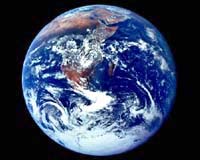
 |
Destruction of the icesheet -- second in size to Antarctica's -- would drive up sea levels by seven metres (22.75 feet) over a thousand years or more, and the process may well be irreversible, it says.
Indeed, tentative evidence suggests the icesheet has already to started to melt, lead author Jonathan Gregory told AFP.
"It's quite possible that Greenland is already making a slight contribution to global sea levels," said Gregory, a meteorologist at the University of Reading, southern England.
Published on Thursday in the British weekly science journal Nature, the research uses a sophisticated computer model to forecast what happens to the icesheet at different levels of carbon dioxide (CO2) emissions -- the gas spewed out by the burning of fossil fuels that drives global warming.
Before industrialisation, the atmosphere contained 280 parts per million (ppm) of CO2. At present it stands at 370 ppm.
The computer model ran through various scenarios, in which CO2 is stabilised at 450, 550, 650, 750 and 1,000ppm.
And it factored in the latest data that points to how parts of the northern hemisphere are particularly vulnerable to global warming.
The risk factor here is a phenomenon called albedo: the ability of a landscape to reflect sunlight.
Ice and snow reflect sunlight, and thus heat. The more exposed a landscape is, the more heat it absorbs; this in turn melts more of the ice, and so the warming process continues, becoming a vicious circle.
In most of the combinations that were crunched through the computer model, Greenland warmed by about 3.0 degrees Celsius (5.4 Fahrenheit) by 2100 compared with 1990 levels, a temperature at which the icesheet starts to contract, for melting will exceed snowfall.
In many cases, the warming is predicted to exceed eight decrees Celsius (11.2 Fahrenheit) by the year 2350, a temperature virtually considered a doomsday by the UN's top scientific body on global warming, the Intergovernmental Panel on Climate Change (IPCC).
The study points out that the lowest CO2 concentration used in the model, of 450ppm, is almost certain to be exceeded by 2050 alone -- and that carbon dioxide is only one of six important greenhouse gases.
"We conclude that the Greenland icesheet is likely to be eliminated by anthropogenic [man-made] climate change unless much more substantial emission reductions are made than those envisaged by the IPCC," the authors say.
"This would mean a global average sea-level rise of seven metres during the next 1,000 years or more."
Even if CO2 levels and global temperatures return to pre-industrial levels, the icesheet may never be regenerated, because Greenland's landmass would have warmed because of the loss of albedo.
The only international agreement on cutting greenhouse gases is the UN's Kyoto Protocol, which requires industrial countries to make a small cut in global emissions by a timeframe of 2008-12.
But the pact is in limbo. It still needs ratification by Russia to take effect and in any case has been abandoned by the United States, the world's biggest CO2 polluter.
TERRA.WIRE |